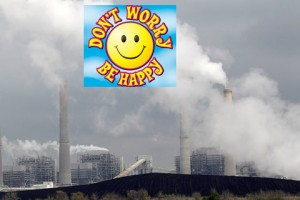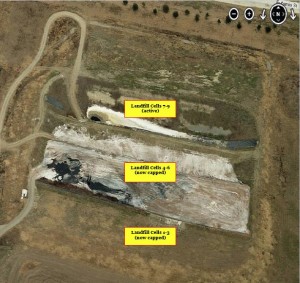Toxicology
Poultry Expert to Doctors: You’re Wrong, Ozone Doesn’t Cause Asthma
 Feigning allegiance to some sort of science the scientists themselves don't use, the Texas Commission on Environmental Quality rejected a petition by the Dallas County Medical Society to put new pollution control equipment on three large coal power plants upwind of DFW, saying there's no real conclusive evidence that smog causes respiratory problems like asthma.
Feigning allegiance to some sort of science the scientists themselves don't use, the Texas Commission on Environmental Quality rejected a petition by the Dallas County Medical Society to put new pollution control equipment on three large coal power plants upwind of DFW, saying there's no real conclusive evidence that smog causes respiratory problems like asthma.
It may come as a surprise to newcomers, but the largest state environmental agency in the U.S. has never recognized a connection between ozone pollution, or smog, and respiratory problems. Austin has fought the implementation of every new ozone standard ever proposed by EPA and played down any causal link suggested by recent studies. If you want to know what's behind the current push in the US House of Representatives to discredit the historical "6-Cities Study" – the basis for the original connection between smog and public health, look no further than the Texas Commission on Environmental Quality, where such mainstream science has never been accepted. It's not in industry's interest, or the pro-industry-constantly-running-for-something Governor, whose fingerprints so besmirch the TCEQ these days, even new file clerk positions are considered ideological appointments.
TCEQ Chairman Bryan W. Shaw said studies suggest that cutting ozone alone might not prevent asthma attacks.
“I’m convinced that it doesn’t make sense to get ahead of the science,” Shaw said. He later added, “I don’t want there to be this knee-jerk reaction.”
Commissioner Toby Baker said asthma has “a wealth of confounding factors.” To assume that a correlation between high ozone and asthma hospitalizations means ozone causes asthma is “frankly irresponsible,” Baker said.
That would be Bryan Shaw, A&M Poultry Science major, and Toby Baker, A&M Public Administration major. Both of them have the same amount of expertise in medicine and public health, which is to say none. But that doesn't stop them from discounting the doctor's own experience with layers of condescension.
“We’re still seeing harm to our patients on high ozone days,” Dr. Robert Haley, a professor at UT-Southwestern Medical Center, told the commissioners. “The fact remains that the Dallas-Fort Worth area has among the worst ozone levels in the nation, Dr. Robert Haley, a professor at UT-Southwestern Medical Center, told the commissioners.“
But the Commissioners had an answer for that concern too: just wait for our next DFW clean air plan! In 2015! To address smog problems that don't worry us at all! That will be just as effective as the last one! Which ended with higher ozone levels than when it started! Which is why we definitely do not need to better control the air pollution from big, obsolete coal plants!
See how that little bit of misdirection works?
The only way DFW will ever see real clean air progress while Rick Perry's TCEQ is in charge is if local governments do it on their own. No amount of professional public health concern is enough to outweigh the total Rick Perryization of the agency. Not even when it comes from 7000 Dallas County doctors.
Meanwhile, good on Public Citizen, Dr. Haley, and the Dallas Medical Society for creating the most high-profile intervention to date into DFW air pollution politics by the local medical community. And we'll hold Haley to his promise that the group is going to "continue to push for cleaner air," because folks could sure use the help – and not just with East Texas coal plants. Soon they'll be meetings of the North Texas Clean Air Steering Committee to discuss that next TCEQ air plan for DFW. It's a local air policy committee with no health professional as a member. Perhaps The Dallas Medical Society would like a seat?
And on Thursday November 7th, the EPA is hosting what it calls a "listening session" on proposed new rules for carbon emissions from all power plants including the East Texas coal-powered ones, at the downtown Dallas Library from 10 am to 3 pm. Implementing these rules would most likely internalize too many of the costs that are being absorbed by the environment now for these dinosaurs to keep operating profitably. So even though the docs lost the battle in Austin on Wednesday, the war is still capable of being won. Stay tuned.
World Health Organization: Air Pollution Causes Lung Cancer
 As of Thursday, the air you breathe CAN kill you, at least according to the World Health Organization, which officially classified air pollution as a cause of lung cancer. The move came after the group released a report earlier this year estimating that over 220,000 people died from lung cancer worldwide from exposure to bad air. Most of those deaths are occurring in countries in Asia.
As of Thursday, the air you breathe CAN kill you, at least according to the World Health Organization, which officially classified air pollution as a cause of lung cancer. The move came after the group released a report earlier this year estimating that over 220,000 people died from lung cancer worldwide from exposure to bad air. Most of those deaths are occurring in countries in Asia.
Mostly these deaths are due to Particulate Matter pollution, the ubiquitous tiny particles of soot that are produced when things burn, like gas in cars, coal or gas or waste in power plants and cement kilns, and diesel engines and flares in the the gas fields.
Researchers have been producing one study after another for years linking a variety of illness and diseases to various ingredients of dirty air and specifically, Particulate Matter. Parkinson's Disease and other nerve and brain-related ailments, heart attacks and strokes, and of course respiratory problems have all been blamed on PM, but this is the first time it's been classified as a carcinogen. Most scientists in the field believe that there's really no level of exposure to the pollution that's completely "safe."
PM levels in DFW are generally low, but they've been rising over the last couple of years, and those measured levels are based on all of two monitors for all of the Metromess, so they could mask hot spots downwind of large sources (think Midlothian, compressors, and busy freeways). The EPA has proposed a new federal standard that's much lower than the current one, but it has yet to be implemented.
New Studies Link Air Pollution to Pregnancy Risks
 Two new studies provide more evidence that current air pollution standards are not protective of human health.
Two new studies provide more evidence that current air pollution standards are not protective of human health.
On Monday, the British Medical Journal, The Lancet, published the results of a huge European-based examination of the effects of Particulate Matter pollution (PM) on the birth weight of newborns. It pooled 14 different previous studies that included more than 74.000 mother-child pairings over 12 countries.
Concentrations of PM below the current European Union standard of 25 micrograms per cubic meter of air – twice the new US standard proposed by EPA in 2012 – were linked to low birth weigh babies. The authors estimated that for every 5 micrograms increase in PM, there was a corresponding 18% increase in there risk of giving birth to an underweight child. Most scientists looking at data like this suggest there really is no safe standard for exposure to PM – that is, any amount can be harmful to health in some way. In this case, the PM was going from mother to child and affecting its health even before coming out of the womb and taking its own first breath.
“We have evidence from animal studies that the tiniest particles enter the bloodstream and go to the fetus,” said the senior author, Rémy Slama, a senior investigator at the Institute of Health and Medical Research in Grenoble, France. “Can we expect other health effects in these children? There are hints that there might be — low birth weight is a marker of negative effects in adulthood.”
PM Pollution comes primarily from types of combustion, like flares in the gas field, power plants, cement kilns and yes, your internal combustion engine in you car. PM pollution is dense along heavily-traveled roads and highways. This kind of information is slowly beginning to impact urban planning. You probably don't want to put an elementary school next to a freeway, or an apartment complex at an intersection. Likewise, you want to try to avoid living directly downwind of thick plumes of the stuff coming from, say an industrial complex that hosts three cement plants and a steel mill. i.e Midlothian.
A University of Florida study that came out last week concluded that pregnant women who live in areas with high levels of air pollution were more likely to suffer from high blood pressure. In this case, the health of approximately 22,000 pregnant women were correlated to readings from local air monitors. Those women living closer to monitors registering high levels of air pollution – defined as not only PM, but smog-forming Nitrogen Oxide and Volatile Organic Compounds – were 12 to 24 % more likely to also have high blood pressure. Although flawed in some important ways by not ruling out variables like weight, the report falls in line with previous studies linking air pollution to blood pressure spikes.
Ed Ireland is Down to the Scientific Stems and Seeds
 Maybe the Barnett Shale Energy Education Council thought it was being cute by sending their latest "study" out on the day Gasland II had its theatrical premiere in North Texas.
Maybe the Barnett Shale Energy Education Council thought it was being cute by sending their latest "study" out on the day Gasland II had its theatrical premiere in North Texas.
Or maybe they knew what an egg they were laying. It's a basic rule of PR that you don't send things out on a Friday that you actually want people to see. And if you were the industry, even you might be a little embarrassed about this thing too. As of Tuesday afternoon, the group was so proud of it, they hadn't even posted it on their on website. As far as we can tell, it's details have only appeared within stories from in-house publications like the Star-Telegram.
Imagine the pitch on paper, if there was one. "We'll fund our own research so that it'll have maximum credibility. And since we can't find a reliable academic institution to do it for us, we'll have to contract to something called ToxStrategies out of Houston. We won't do any new research at all. We'll just regurgitate the state's own lame monitoring data. We'll take the seven stationary monitors that have screened for air toxics in North Texas – you know, the ones that ony take samples every sixth day (when they were operational), and let that represent the entire Barnett Shale. We'll only look at some Volatile Organic Compounds readings. We won't connect any gas drilling or production taking place to a timeline to show what activity was actually going on around these monitors, so they'll be no way to correlate our presence with increases or decreases in pollution. And of course, since we're using TCEQ monitoring data, we can also use their unsupported claims that there are "safe levels" of benzene and other carcinogens when the most recent science is in direct opposition to that discredited idea."
And that's about it. Old TCEQ monitoring data that may or may not have any correlation to drilling activity is used to once again say, "Look Ma, no health effects!" Think of it as the "Titan Study Part 2."
Industry and regulators always want to start at the smokestack end of things and draw assumptions of human health from that end. As long as pollution is below certain levels that they just know are "safe" (until one day' they're not), they connect the dots and say there is no human harm occurring. They really don't want to actually go out and test that theory among real people on the ground living next to these facilities. They might find it doesn't hold up very well. That's why they want to stick to reviews of monitoring data.
Citizens always want to start from the other end – real life. Let's test that hypothesis about safe levels of poisons and see what the rate of asthma, cancer, miscarriages there are in the neighborhoods around and downwind of these sources. Are the rates of illness higher or lower the closer you get to a facility? Is there any correlation between the types of illnesses and any chemical in the atmosphere or water, no matter how safe the exposure level? And you know what, when it comes to fracking, there seems to be a lot of difference between what the studies that rely on real life say versus what the studies that rely on measurements say, like this "new' old effort released about a quarter to five on a Friday afternoon.
But hey, It can't be the BSEEC without the BS.
Expert: Clean-Up at Frisco Lead Smelter Site Should Be 100x Stricter
 (Frisco) — Representatives of local groups that were instrumental in shutting down the ill-fated Exide lead smelter in Frisco say the company is now using the wrong environmental standard to direct the clean-up of the facility and surrounding property.
(Frisco) — Representatives of local groups that were instrumental in shutting down the ill-fated Exide lead smelter in Frisco say the company is now using the wrong environmental standard to direct the clean-up of the facility and surrounding property.
Their primary source is testimony from an Austin engineer hired by the City of Frisco that says the smelter decontamination should be governed by toxic contamination standards that are 100 times stricter than the ones currently being used.
"Based on evidence already in the record and cited by the City's new expert, its clear that Exide is trying to get away with a cheaper, less protective clean-up than the Agency's own regulations demand," said Colette McCadden, the Chair of Frisco Unleaded, the citizens group that campaigned for almost a year to successfully close the last secondary lead smelter in Texas.
She referred to testimony submitted by Austin-based engineer William Wheatley in July on behalf of the City of Frisco for Exide's bankruptcy proceedings. In it, the former Director of the Waste Permits Division for the Texas Commission on Environmental Quality (TCEQ), concludes that the company is erroneously using a less-protective classification for categorizing the groundwater running underneath the smelter site.
That classification is the basis of all decontamination and closure efforts at Exide, including how to deal with a still-active landfill full of lead waste.
In his testimony, Wheatley explains what this mistake means in practical terms when it comes to cleaning up lead contamination at the site:
"Exide is operating under the assumption that a Class 3 groundwater designation will be approved and, as a result, that remedial action levels for soils at the site will be less stringent (in most cases, soil action levels based on Class3 groundwater would be 100 times the levels that would be required for Class 2 groundwater).
It is my opinion that existing information clearly demonstrates the groundwater at the site is Class 2 and significantly more stringent action levels are therefore appropriate and necessary."
Jim Schermbeck, Director of the clean air group Downwinders At Risk accused Exide of purposely trying to get by with a cheaper clean-up in Frisco because it's already bankrupt. He applauded the City for hiring an independent expert who could provide oversight of the company's claims, and double-check the state's assertions as well.
"The city is finally providing a much needed second opinion on the way Exide is conducting its clean-up of the smelter site. We hope it listens to its own expert and demands a clean-up that's 100 times better than it has been to date."
At issue is whether there's sufficient groundwater flow underneath the smelter site to categorize it as a Class 2 or Class 3 groundwater resource under state rules.
If a well produces more than 150 gallons of water a day, then it's a Class 2 resource. Below that number and it's a Class 3.
The difference is not only a soil clean-up standard that's 100 times stricter, it also means more work for Exide in cleaning up existing groundwater contamination that's not acceptable when the higher standard is applied.
Wheatley doesn't mince words in calling out the company's mistake, stating,
"(Exide's engineering consultants) concluded that groundwater at the site is not impacted. However, as discussed below, that conclusion is based in part on the characterization of the uppermost groundwater bearing unit as a "Class 3" groundwater resourceIt is my opinion that a "Class 3"designation is unsubstantiated and technically incorrect based on currently available information which clearly indicates that the groundwater is a 'Class 2' resource."
Frisco Unleaded and Downwinders both used Wheatley's report for the City to request that the state reject Exide's planned remediation of its active landfill in official comments that were submitted last Friday because, they said, that plan is based on the wrong groundwater classification.
After a swift campaign that closed the smelter last year, it's been a more difficult task to deal with decades of toxic contamination. In June, Downwinders and Frisco Unleaded released City of Frisco reports that showed widespread lead-contaminated waste in Stewart Creek, including parts of the City's planned "Grand Park."
Citizens say it's unacceptable to leave tons of lead waste behind in Frisco, as Exide wants to do, because it would mean the creation of an economic and public health "dead zone" in the middle of town.
"We know we have to get this right the first time because we night not get a second chance, "said McCadden, who's lived in Frisco since the mid-1990's. "We have to demand the most protective clean-up we can get under the law."
Study: Carbon in Particulate Matter Air Pollution Kills
Carbon soot found in Particulate Matter air pollution is responsible for increasing death risks in US cities according to a new nationwide study conducted by John Hopkins, Yale and Harvard.
“Our work indicates that some constituents of PM2.5 may be more toxic than others and therefore regulating PM total mass alone may not be sufficient to protect human health,” the authors wrote in Environmental Health Perspectives.
Figuring out which ingredients are the most dangerous could help local air pollution agencies hone in on certain sources, making regulations more targeted.
“By identifying PM2.5 constituents that are more toxic, we can move towards developing source-specific air pollution regulation that may be more effective at protecting public health,” the authors wrote.
The study included data from 72 American cities, but that data was limited in a way familiar to downwinders – PM monitors often only took measurements every 6th day.
Particulate Matter, or PM, are microscopic leftovers of combustion that you can not only breathe, but also absorb into your blood stream. PM pollution has been linked to an increasing number of health effects, including asthma, heart attacks, strokes, and immune and brain disorders. Many scientists identifying these effects have concluded there probably isn't a "safe" level of exposure to PM – that any amount is capable of doing some kind of short or long-term harm.
PM pollution comes out of everything that burns something – fires, boilers, furnaces, and internal combustion engines. Locally, cars and trucks, the Midlothian cement plants, and the natural gas industry are the largest sources of industrial PM.
Study: Maternal Smoking During Pregnancy Can Cause Asthma In Your Great Grandchildren
 And the evidence just keeps piling-up that we have no clue about the public health impacts of poisoning ourselves.
And the evidence just keeps piling-up that we have no clue about the public health impacts of poisoning ourselves.
Over the past few years, more and more science dollars have been committed to studying the "epigenetic" impact of toxins in the human body. These are impacts that go well beyond just the person originally exposed to those toxins. We expect that harm. What's brand new is the fact that that exposure can keep harming the descendants of the original victim. His or her children could be impacted, or his or her grandchildren, or even great-grandchildren. Individuals who might be born long after the offending facility is out of business can nevertheless still be impacted by its poisons as the get passed along from generation to generation.
This happens not through direct DNA damage, but by damaging the code and behavior of the stuff surrounding the DNA and telling it what to do. This damage can cause a normal cell to go haywire. Changes can be subtle or dramatic. Maybe cancer, maybe a immune system disease, and maybe asthma.
Researchers at the UCLA Medical Center have published a study that concludes that mothers who smoke during pregnancy have a statistically higher risk of causing asthma in their great grandchildren.
"Even though there are multiple causes for childhood asthma, research linking this serious chronic condition to maternal nicotine exposure during pregnancy for up to three generations should give mothers-to-be even more reasons to reconsider smoking,’ said Dr Virender Rehan an LA BioMed lead researcher. "
Follow-Up: Silica Air Pollution at Fracking Sites Out of Control
 Last summer we told you about a nationwide Centers For Disease Control/National Institute for Occupational Safety and Health (NIOSH) warning to gas and oil field workers about rampant silica air pollution at fracking sites throughout the country. Research had found that pollution standards were being trampled at every site they tested. These were all tests done within the fence line of the well site, so nobody knows what the off-site impacts were/are, or how far downwind they can extend.
Last summer we told you about a nationwide Centers For Disease Control/National Institute for Occupational Safety and Health (NIOSH) warning to gas and oil field workers about rampant silica air pollution at fracking sites throughout the country. Research had found that pollution standards were being trampled at every site they tested. These were all tests done within the fence line of the well site, so nobody knows what the off-site impacts were/are, or how far downwind they can extend.
Now comes a recent follow-up report that breaks down all the information that was the basis of that 2012 industry warning, and its gruesome. Because it's so detailed, we're pasting it in blocks below in one narrative feed.
Fracking uses a lot of sand. There's an entire silica pollution cycle within fracking that's only now getting the attention it deserves. The mining of sand for fracking can take place miles away from the gas or oil plays and threaten new areas never touched by a well. It takes lots and lots of water. There are lots and lots of trucks, and lots of silica in the air at the mine. Just ask the folks along the Red River, to the northwest of DFW in what used to be pristine rolling timbered hill country.
Once it gets to the fracking site, it creates the clouds of silica air pollution that OSHA is so concerned about. The level of exposure the feds found at some of the fracking sites they studied was "enough to overwhelm the maximum use concentration ratings for the half-mask, air-purifying respirators that workers typically wore" while working at the site. Breathing silica is like breathing sand or cement into your lungs. Eventually it fills them up and hardens your air passageways and you suffocate to death. Happens in the cement industry a lot. We know this is a real and current hazard to workers at the site. We have no idea what kind of hazard it is to people off-site. None. Zero. Nada.
This is why regulators must be cautious in deciding things like "setback distances." The difference between 1000 and 1500 feet could be a dramatic drop-off in silica pollution. That could be an important margin of error for public health we need but don't know much about right now.
Here's the story from Robert Iafolla in Bloomberg:
Workers' Silica Exposure at Fracking Sites Far Exceeds OSHA Limit, NIOSH Study Finds
The concentration of silica in the air workers breathe exceeded occupational health criteria at all 11 hydraulic fracturing sites tested by the National Institute for Occupational Safety and Health, the American Industrial Hygiene Association announced July 31.
Researchers measured the silica levels of more than 100 personal breathing zone samples at fracking sites in five states, finding levels above the Occupational Safety and Health Administration's permissible exposure limit (PEL), NIOSH's recommended exposure limit (REL), and the American Conference of Governmental Industrial Hygienists threshold limit value (TLV).
In some instances, the samples exceeded OSHA's PEL by a factor of 10 or more. That level of exposure is enough to overwhelm the maximum use concentration ratings for the half-mask, air-purifying respirators that workers typically wore, the study said.
“Although effective engineering controls for crystalline silica are well established in other industries, controls to limit silica-containing dust generation during hydraulic fracturing are only now emerging due to the relatively recent understanding of the hazard and magnitude of exposure risks,” the study authors wrote.
The study appears in the Journal of Occupational and Environmental Hygiene, published jointly by AIHA and ACGIH.
NIOSH first flagged the occupational hazard of silica exposure at fracking sites in a June 2012 Hazard Alert. The journal article describes the research that informed that alert (42 OSHR 576, 6/28/12).
Silica sand is a crucial and common component in many fracking operations. Silica is often mixed with the water and chemicals injected into shale formations during fracking, with silica acting as a “proppant” to keep the underground fractures open to allow oil or natural gas to flow. Approximately 28 million metric tons of silica sand was used in fracking during 2012, according to the U.S. Geological Survey.
The heavy use of silica is reflected in the air contamination at fracking sites. Just over half of the 111 samples that NIOSH tested exceeded the PEL for silica, while 69 percent exceeded the REL, and 84 percent exceeded the TVL.
OSHA's PEL is calculated from the percent of crystalline silica in the respirable dust; the PEL for 100 percent silica would be 0.1 milligram per cubic meter of air. NIOSH's REL is 0.05 milligram per cubic meter, and the ACGIH's TVL is 0.025 milligram per cubic meter.
OSHA's proposed regulations for silica could lower the PEL to 0.05 milligram per cubic meter, although that has been met with fierce resistance from industry. The proposal has been on hold at the White House Office of Management and Budget since February 2011.
Researchers took samples at fracking sites at five shale formations: Bakken in North Dakota, DJ Basin in Colorado, Eagle Ford in Texas, Fayetteville in Arkansas, and Marcellus in Pennsylvania. The fracking operations at those locations used silica as the proppant, with the exception of the Bakken site, where 60 percent of the proppant was a ceramic material.
None of the 10 samples taken at Bakken exceeded OSHA's PEL. Two-thirds of the samples at Marcellus, 54 percent at Fayetteville, 53 percent at DJ Basin, and 50 percent at Eagle Ford went over the PEL.
Typical fracked gas or oil wells go through 12 to 20 stages, with each stage requiring hundreds of thousands of pounds of sand, creating airborne dust at the sites, the study said.
Sand is delivered from tractor trailers and pumped with compressed air through fill ports into on-site storage and delivery vehicles known as “sand movers.” Those sand movers use motor-driven belts called “dragon tails” to supply sand to blender trucks, with larger loads requiring multiple vehicles moving sand across a transfer belt. Blender hoppers pump the sand-as-proppant through a manifold, piping, and into the well.
Workers operating sand movers and transfer belts are exposed to the highest levels of silica, the study said.
Overall, the study found seven points of dust generation that were common at all 11 sites:
• from “thief hatches” on the tops of sand movers during filling,
• from the sand mover belt,
• from the momentum of falling sand below the dragon tail at the blender hopper,
• from transfer belts when sand is deposited onto the belt and conveyed to the blender,
• from sand leaving the end of the dragon tail,
• from fill ports of sand movers during refilling operations, and
• from truck traffic at the fracking site.
The study said that about 435,000 workers were employed in the U.S. oil and gas extraction industry during 2010, with nearly half employed by well servicing companies, including companies that use fracking.
The study “Occupational Exposures to Respirable Crystalline Silica During Hydraulic Fracturing” is available at http://tinyurl.com/mn5sbc3.
Past Colorado Medial Society Prez: Fracking is an “Experiment in Motion” on Public Health
 Dr. Michael Pramenko seems like a reasonable guy. He's not a Greenpeace treesitter, or running for elected office, or part of any unruly mob.
Dr. Michael Pramenko seems like a reasonable guy. He's not a Greenpeace treesitter, or running for elected office, or part of any unruly mob.
In fact, he's so reasonable that he's the former president of the Colorado Medical Society.
And Dr. Pramenko calls the current hydraulic fracturing boom in the state’s oil and gas industry an “experiment in motion. One that could lead to higher rates of cancer and other illnesses over the next 10 to 15 years."
But he's not concerned with the massive acute exposures that can happen during accidents or blow-outs. No, he's concerned with the harm done by the routine, boring everyday kind of low-level chronic exposure that the Texas Tech researchers in the post below are documenting.
“Are there people out there being exposed to low quantities [of carcinogens] that we won’t ever know about? Sure,” he said. “Are there going to be some cancers down the road that come about across the United States? I think that's true.
You'll be relieved to know that state regulators have everything under control. Colorado Department of Public Health and Environment (CDPHE) spokesman Mark Salley said the department closely monitors the industry to protect public health: “The [CDPHE] has regulations in place, including required permitting, set-back requirements, use of ‘best practice’ methods by industry to minimize the impacts.”
Yes, that should do it.
There are 50,771 active oil and gas wells in Colorado – 20,260 of them in Weld County on the northern Front Range. More than 90 percent of the state’s wells are fracked at least once and often multiple times.
Trying to regulate fracking hazards is like trying to hit a moving target. Every month there's a new study out that shows a new threat or one that has been under-emphasized. Like so many other on-going experiments we're a part of, this one will claim thousands before we understand what was really happening.
Another Study Reveals Why Our System of “Safe Levels” is a Tragic Mirage
 Gas well, cement plant, lead smelter, plastics plant, refinery, compressor, incinerator. Anyone who's ever lived next door to an industrial polluter knows there's the way the facility appears to be operating on paper and how it's actually operating in the real world.
Gas well, cement plant, lead smelter, plastics plant, refinery, compressor, incinerator. Anyone who's ever lived next door to an industrial polluter knows there's the way the facility appears to be operating on paper and how it's actually operating in the real world.
The way it's operating on paper is completely portable. You can take this version of the facility anywhere. The numbers and printouts and charts can show up to congressional hearings. They can be included in PowerPoint presentations, along with glossy pics of the place itself. They can be summarized. They have no smell. They have no texture. They don't make a sound. On paper, expressed in language and figures, the facility may seem to be operating properly under every permitted limit it has to abide by.
On the ground however, it may be a completely different story. It may mean strange petrochemical or plastic smells wafting through your house in the middle of the night. It could mean a series of loud explosions or pops that nobody has ever been able to explain to you. It could mean rashes on your skin, or headaches, or nausea, or asthma attacks. It could mean living in fear of chemical assault. All the time.
This version of operations is not portable. One can write about it or talk about it, but that will not put other people there. And indeed, descriptions of these circumstances can sound so nightmarish that listeners assume you're exaggerating. You're not. Not even video or film can immerse you in it. No amount of reporting about it can make you feel in it. The map is not the place. The only way to know this side of operations is to live it. Day in, day out.
The difference between what the paper version of polluting says, and what the people living it know, is a front line of social justice in the 21st Century.
It also happens to be a major frontline for science, as demonstrated by a recent landmark study from, of all places, Texas Tech about how the sum of pollution is greater than its sometimes desperate parts We're late in covering this, but thanks to the Denton Record Chronicle's for bringing it to our attention back in June. Because this study underscores once again in a big way why our entire system of regulating chemical exposures is so completely contrary to what we know about how those exposures are affecting us.
Tech scientists took two chemicals that are known to cause cancer in large amounts, arsenic and estrogen, and exposed human prostate cells to very low amounts of each. The amounts they exposed the prostate cells to were so low, they fell below the EPA regulatory "safe" level that limits releases of the chemicals from polluters. Individually, the exposures of the cells to arsenic and estrogen were so low as to believed to be harmless. But they weren't.
Instead, the Tech researcher's peer-reviewed, journal-published study found the combination of the low doses of the two chemicals combined was almost twice as likely to create cancer in the prostate cells as the single chemical exposures individually. That is, the toxic interaction or "cumulative effect" of the two chemicals was more than the sum of their parts. There was a "synergestic" reaction inside the cells that the current regulatory system doesn't recognize as even a possibility.
“The majority of cancers are caused by environmental influences,” Singh said. “Only about 5 to 10 percent of cancers are due to genetic predisposition. Science has looked at these chemicals, such as arsenic, and tested them in a lab to find the amounts that may cause cancer. But that’s just a single chemical in a single test. In the real world, we are getting exposed to many chemicals at once.”
Singh became interested in looking at arsenic because water well problems in his native India had recently highlighted mass poisonings from contamination of the chemical. He wondered how this exposure would interact with other carcinogens within the same population.
He focused on estrogen as the second chemical because of the chemical’s ubiquity. Many plastics, such as food can liners, release bisphenol A (BPA), and other chemicals that mimic estrogen in the body.
Unlike more potent chemicals that do major damage to the DNA in a cell, such as benzene, arsenic and estrogen aren’t major mutagens Singh said. Instead, their presence tends to stop certain genes from expressing. The process is called DNA hypermethylation.
…the two chemicals stopped the MLH1 gene, which is responsible for sending the signal to start the self-destruct sequence when a cell is damaged. Because the self-destruct couldn’t activate, the cells became cancerous after exposure.
“With the lower dose not killing the cell, it’s causing damages that go under the cell’s radar. We found when you have two compounds together, lower doses could be more serious problem.”
This is what's called a non-linear impact. You can actually get harmed more by long term low-level exposures than by intense bursts of short term exposure – exactly the opposite of the way the system regulates chemical exposures now.
Currently that system assumes it can protect the public health from exposures to over 80,000 chemicals on the marketplace by regulating the average intake of these chemicals one at a time. It says: "we know that lead and benzene are bad for you if you OD on them, but by only exposing you to a little bit every day, we can keep you from getting damaged by its health effects." The dose is the poison. A little bit cant hurt you, but a lot can kill you.
Unfortunately, this view, which is the foundation for all modern regulatory schemes for chemical pollution, is based on a worldview of human physiology that's now dangerously out of date. For the past 50 years at least, study after study has shown that there are a lot of less-than-drop-dead health effects that couldn't be diagnosed without modern technology. The more we learn about how how bodies work the more we learn new ways about how chemicals can really screw them up. The Tech study is just the latest, albeit dramatic example.
Moreover, of those 80,00 chemicals only about 200 can be said to have been studied even remotely "thoroughly" and fewer that that have been examined for their interactions with any of the other 79,999. So the system itself is a big fat theory in progress, with very little real science supporting it. We're all its Guinea Pigs. It's an hypothesis.
But its a hypothesis with billions invested in it. So to prove it wrong is to threaten a lot of people with a lot of money.
Which is why the chemical industrial-government complex is trying very hard to hold back the tide of this kind of science and what it means. Meanwhile the gap between the paper version of how things are operating at a facility and the real world impact of those operations continue to grow. At some point the contradictions will be too much to ignore or withstand. But we're a long way from that point yet. Which is why we need your help to keep fighting on behalf of those folks living the truth on the ground and prevent more victims of this obsolete and harmful regulatory system.

